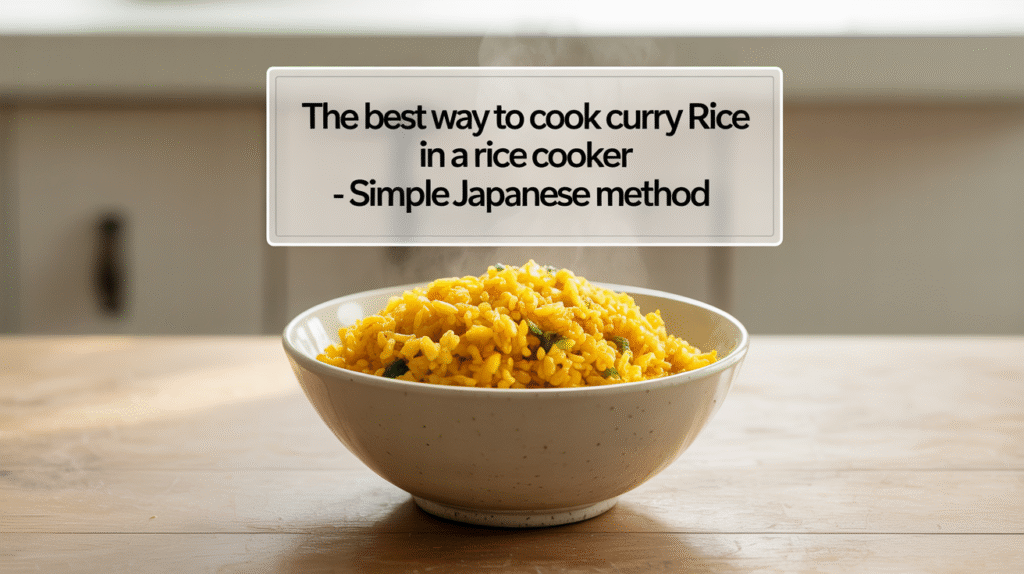The easiest way to make curry rice in a rice cooker is to cook rinsed short‑grain rice together with a mild Japanese curry base, vegetables, and protein, letting the cooker do the work of steaming and flavour absorption. This method produces tender, fluffy rice infused with savoury curry flavours in one pot.

What Is Curry Rice?
Curry rice (kare raisu in Japanese) is a staple comfort dish in Japan, often made with a block of curry roux, potatoes, carrots, and onions simmered into a thick sauce. While typically served over plain rice, cooking the curry and rice together in a rice cooker creates a quicker, one‑pot version that saves time and reduces washing up.
Why a Rice Cooker Works
Rice cookers hold steady moisture and temperature, allowing rice to absorb the curry flavours as it cooks. This method simplifies meal prep while maintaining authentic Japanese taste.
Ingredients for Curry Rice in a Rice Cooker
Balanced ingredients ensure proper cooking and flavour.
Core Ingredients
- 2 cups short‑grain white rice (300 g), rinsed thoroughly
- 2¼ cups water or light stock (540 ml)
- 1 small onion, sliced
- 1 medium carrot, diced
- 1 small potato, diced
- 150 g chicken thigh or breast, cubed (optional for protein)
- 2 cubes Japanese curry roux (store‑bought block, usually from Golden Curry, Vermont Curry, etc.)
Optional Additions
- ½ cup frozen peas or corn for colour and sweetness
- 1 tbsp soy sauce for deeper umami
- Chopped parsley or spring onion for garnish
Step‑by‑Step Instructions
Cooking curry rice in a rice cooker is simple if you layer ingredients correctly.
- Rinse the rice until the water runs mostly clear, then drain well.
- Place rice in cooker and add water or stock at the measured ratio.
- Layer vegetables and meat evenly over the rice.
- Add curry roux cubes, placing them on top so they dissolve gradually during cooking.
- Start the rice cooker on the “White Rice” or “Mixed Rice” setting.
- Allow the cooker to finish; it usually takes 30–45 minutes depending on model.
- Rest 10 minutes after cooking before opening to allow moisture distribution.
- Stir gently with a rice paddle to mix curry evenly into rice.
- Serve hot, garnished with parsley or spring onion if desired.
Cook Times and Yield
Timings vary by machine but remain within typical ranges.
- Basic rice cookers: 25–30 minutes cooking + 10 minutes resting
- Fuzzy logic or multicookers: 40–50 minutes cooking + 10 minutes resting
Yield: About four servings from 2 cups of uncooked rice with curry vegetables.
Variations of Curry Rice
You can tailor curry rice to your preferences by changing ingredients or flavour levels.
Protein Options
- Chicken thighs for tender bites
- Beef strips for hearty flavour
- Tofu cubes for a vegetarian option
Flavour Adjustments
- Add apple or honey for sweetness
- Increase curry cubes for a stronger, spicier flavour
Tips and Common Mistakes
These practical points help ensure reliable results.
Tips
- Cut potatoes and carrots into small, even pieces so they cook through.
- Use stock instead of water for extra flavour.
- Resting time after cooking is essential for texture and flavour balance.
Mistakes to Avoid
- Adding too much curry roux can overwhelm and make rice soggy.
- Overfilling the rice cooker may cause uneven cooking.
Troubleshooting
Problems can occur if the ratios are off, but most issues are easily fixed.
Rice Too Wet
Reduce water slightly next time or add fewer curry cubes.
Rice Too Dry
Increase water by 2–3 tbsp or stir in a little hot water after cooking.
Curry Flavour Too Weak
Stir in an extra dissolved curry cube after cooking while rice is hot.
Serving Suggestions
Curry rice works well as a complete meal but can also be part of a larger spread.
- Serve with a side of pickled daikon (takuan) or fukujinzuke (Japanese relish).
- Pair with a small green salad or miso soup for balance.
Storage and Reheating
Like other rice dishes, curry rice is best fresh but keeps well with proper storage.
- Refrigerate leftovers in airtight containers for up to 3 days.
- Freeze portions for up to 1 month.
- Reheat in the microwave with a splash of water or steam gently until warmed through.
Nutrition Snapshot (Per Serving, Approx.)
Values vary depending on meat and curry brand, but a typical serving (¼ of recipe) provides:
- Calories: ~280–320 kcal
- Carbohydrates: ~52 g
- Protein: ~8–12 g
- Fat: ~6–8 g
- Fibre: ~3 g
Rice Cooker Compatibility
Most rice cookers can handle curry rice, but the settings used make a difference.
- Basic models: Use the standard white rice cycle, ensuring ingredients don’t exceed the max line.
- Fuzzy logic/multicookers: Choose “Mixed Rice” or “Stew/Rice” modes for best flavour integration.
FAQs
Here are some questions and answers about Curry Rice (Japanese Curry Base) in a Rice Cooker.
Can I use brown rice instead of white rice?
Yes, but you’ll need more water (about 2½–2¾ cups for 2 cups rice) and longer cooking time.
Can I use instant curry sauce instead of cubes?
Yes, but add it after cooking by stirring into hot rice, since liquid sauces may affect water balance.
Do I need to pre‑cook the chicken or vegetables?
No, small cubes of chicken and evenly cut vegetables cook fully in the rice cooker.
Can I make it vegetarian?
Yes, use vegetable stock and omit meat, or add tofu and extra mushrooms.
How do I make it spicier?
Choose a hot curry roux or add chilli flakes, cayenne, or gochugaru during cooking.
Can I double the recipe?
Yes, if your rice cooker is large enough. Keep the same ratios but never exceed the maximum fill line.